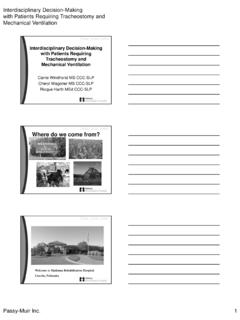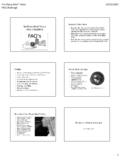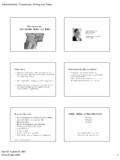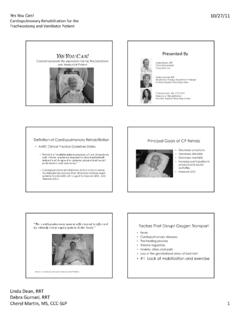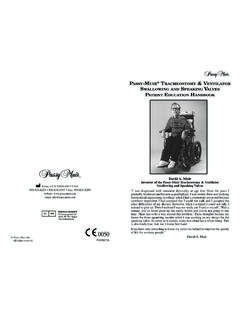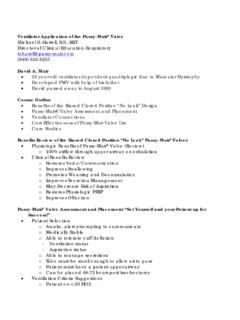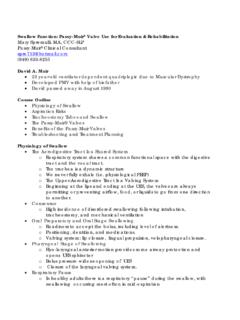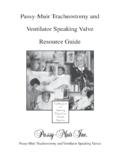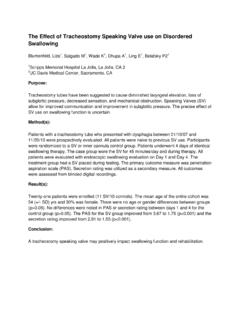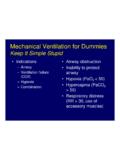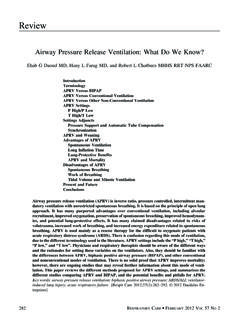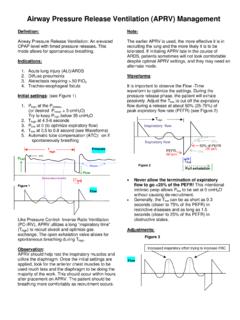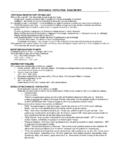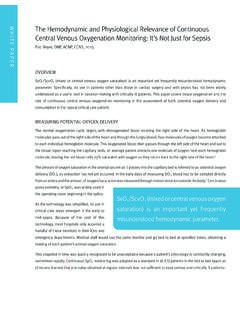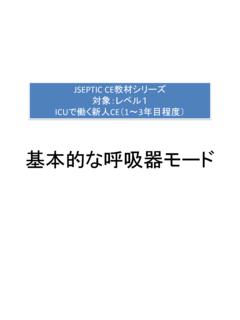Transcription of Ventilator Basics for the Non-RT Linda Dean, RRT
1 Ventilator Basics for the Non-RT Linda Dean, RRT Clinical Specialist (949) 833-8255 David A. Muir 23 year-old Ventilator dependent quadriplegic due to Muscular Dystrophy Developed PMV with help of his father David passed away in August 1990 Learning Objectives Define Respiratory Failure Describe 2 Types of Ventilation Identify 4 Common Modes of Ventilation Learn Ventilator RT Terminology: PEEP, FiO2, PIP, Vt Learn the Optimal Ventilator Settings for Passy-Muir Valve In-Line Application Ventilation/Respiration o The act or process of inhaling and exhaling; breathing. Also called ventilation. o Inhale O2, exhale CO2 = Ventilation o Gas exchange/cellular level is Respiration.
2 Structures Respiratory Failure o Defined as inability to maintain adequate ventilation: to maintain normal oxygenation , carbon dioxide elimination, or a combination of both. Indications for Mechanical Ventilation o Respiratory failure / impending respiratory failure multiple reasons o Post op whatever the duration o C-spine injuries - quad o Neuromuscular disease progressing o Central sleep apnea nocturnal ventilation only o Trauma multiple reasons Types of Ventilation - Non-Invasive Non-Invasive Ventilation Invasive Ventilation Invasive Ventilation Respiratory Therapy Terminology Ventilator Settings: Just What Does The Doctor Order? o Mode of Ventilation o Vt = tidal volume (cc or ml) o RR = respiratory rate o FiO2 = % oxygen o PEEP = positive end expiratory pressure o Pressure Support/Pressure Control Ventilator Settings: Things The Doctor Does Not Order o Flow Rate L/min o Alarms Settings o Trigger Sensitivity o Exp % Sensitivity (time limits PS breaths) Types of Ventilation o Volume ventilation = Ventilator delivers the pre-set Vt regardless of the peak pressure required.
3 Volume is a constant. o Pressure Ventilation = Ventilator delivers a pre-set pressure and volume can vary depending on lung compliance/resistance. Pressure is a constant, volume may be variable. o The higher the pressure, the sicker the Ventilation Terminology Modes of Ventilation Alphabet Soup! o SIMV, IMV, w/wo PS synchronized intermittent mechanical ventilation (pressure support is an option) o A/C and/or PC assist control ventilation/pressure control o PRVC pressure regulated volume control o APRV,Biphasic, BiLevel airway pressure release ventilation this pt is typically too sick for Pas on this mode. o CPAP/PS continuous positive airway pressure / pressure support this is a spontaneous breathing mode.
4 O BIPAP bi-level positive airway pressure --- to name a few!! Ventilation Terminology Modes of Ventilation That are Passy-Muir Valve Compatible o SIMV w PS synchronized intermittent mechanical ventilation with Pressure Support for spontaneous breathing o A/C assist control ventilation o PRVC pressure regulated volume control (with all vents?) o CPAP/PS continuous positive airway pressure / pressure support this is a spontaneous breathing mode. o BIPAP bi-level positive airway pressure Ventilator Modes o Assist control (AC) Machine does all the work. If the patient attempts to trigger a breath the vent will deliver the preset volume/pressure setting at the preset rate o Pressure Regulated Volume Control (PRVC) Vent adjusts pressure delivered during each breath to ensure target volume Ventilator Modes (continued) o Synchronized Intermittent Mandatory Ventilation (SIMV) Vent will deliver a predetermined number of breaths per minute at a certain volume/pressure.
5 If the patient initiates breaths, those breaths will be at the patient s spontaneous volumes o Used in beginning of weaning Ventilator Modes (continued) o Pressure support Ventilator delivers a pre-set pressure, volume is variable, during spontaneous breathing. Can be utilized with other Ventilator modes during spontaneous breathing. Low level pressure support overcomes resistance from the Ventilator tubing. High level pressure support is like physical therapy for spontaneous breathing. Ventilator Modes (continued) o Continuous Positive Airway Pressure (CPAP)- During spontaneous breathing only. Patient determines how many breaths per minute will be taken. No preset volumes are presented to the patient.
6 Patient is given continuous positive air pressure to maintain integrity of gas exchange at alveoli. o Final weaning step before tracheostomy collar Ventilator Modes (continued) o BiPAP = (Bi level positive airway pressure) typically used for non-invasive ventilation. Critical Care Application o Consider: - NIPPV mode o NIV (non-invasive ventilation) is typically seen delivered with a face mask, and is referred to as mask BIPAP or mask CPAP, but may be a good alternative mode, with better alarm options for longer term Passy-Muir valve applications. Vision BiPAP Ventilation Terminology Must Knows for Passy-Muir Valve Use! o FiO2 = oxygen % (<50%) o PEEP = positive end expiratory pressure (<10cmH2O) - Pressure in our lungs at end exhalation (the air we can never exhale that maintains lung inflation) o Vt = volume of delivered vent breath (cc s) o PIP/PAP = peak airway pressure (<40)
7 - How much driving pressure from the machine is required to deliver the set Vt Ventilation Terminology Cuff Inflated-Closed Circuit Cuff Deflated-Open Circuit Passy-Muir Valve In-line Ventilator Adjustments Ventilator Alarms for Passy-Muir Valve Applications o Low exhaled Vt and VE alarms o Low pressure alarm MUST be set 5 to 10 cm below PIP o High pressure alarm Should be set 10cm above PIP Ventilator Connections Team Approach o Trach Team o Co-Treatment Strategies o What are the goals ? o How do I get the RT to help me? Educational Opportunities WEBINARS or SELF STUDY COURSES Application of Passy-Muir Swallowing and Speaking Valves Interdisciplinary Tracheostomy Team: Where Do I Start?
8 Ventilator Basics for the Non-RT Ventilator Application of the Passy-Muir Valve Pediatric Tracheostomy and Use of the Passy-Muir Valve Pediatric Ventilator Application of Passy-Muir Valve Swallow Function: Passy-Muir Valve Use for Evaluation & Rehabilitation Passy-Muir Inc. is an approved provider of continuing education through ASHA , AARC and California Board of Nursing Credit
